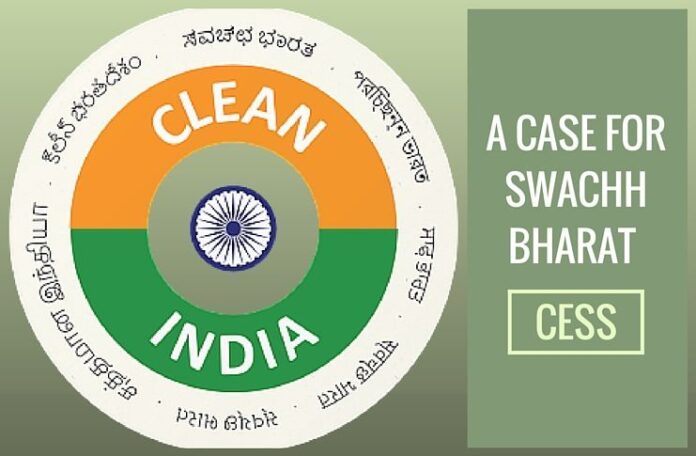
[dropcap color=”#008040″ boxed=”yes” boxed_radius=”8px” class=”” id=””]T[/dropcap]he Swachh Bharat cess of 0.5% on all services has been levied with the objective of mobilizing additional resources necessary to expedite the achievement of the objectives of Swachh Bharat Mission (SBM). The Government proposes to utilize the cess to incentivize the construction and use of toilets for the poor and to finance the creation of infrastructure for collection, transportation, treatment, and safe disposal of solid waste.
According to the NSSO 2012 Survey, just 40.6% of rural households had access to toilets even 65 years after independence. Poor sanitation is directly or indirectly related to around 1000 children dying every day from diarrhoea. It leads to malnutrition, poor learning abilities and poverty. It creates opportunities for violence against women and children. There is a huge economic loss to the nation as well. A 2006 World Bank study estimated that poor sanitation causes an annual loss of $53.8 bn or 6.4% of the GDP by way of death and disease, lower productivity, loss of study and work times, lower tourism, and so on. Unfortunately, the poor bear a disproportionately large share of the burden.
It is in this context that the Prime Minister has launched the SBM as a national campaign to ensure that everyone has access to sanitation facilities and to improve the general cleanliness and sanitation across the country. The SBM is an accelerated program with very ambitious objectives and time-lines. It is proposed to construct about 12 Cr individual toilets and develop solid waste management and treatment infrastructure across the country, all within the next four years. The country today has treatment and disposal facilities for just a small fraction of the solid waste generated daily. A campaign of this scale on such a massive and complex problem requires large resource mobilization.
[dropcap color=”#008040″ boxed=”yes” boxed_radius=”8px” class=”” id=””]K[/dropcap]eeping this is view, the levy gives effect to the budget announcement to impose a cess on all or select services to fund the Mission. It also implements the recommendations of the sub – group of Chief Ministers on the Swachh Bharat Abhiyan. The sub-group, with the Chief Minister of Andhra Pradesh as Convenor, and consisting of the Chief Ministers of Bihar, Delhi, Haryana, Karnataka, Maharashtra, Mizoram, Sikkim, Uttarakhand, West Bengal recognized the national importance of the programme. The cost of implementation of the programme was assessed to be approximately ₹2,23,692 crore ($33.7 billion), and the sub-group recommended an enabling provision to empower Central Government to impose Swachh Bharat Cess on all or certain taxable services at the rate of 2% on the value of such taxable services as announced in the Union Budget 2015-16.
By specifically linking it with SBM, the cess would make every citizen a direct partner and contributor towards addressing a problem which is caused by everyone and affects everyone. Besides, to the extent of being direct contributors, a cess would also increase the public accountability for its effective implementation.
Since the campaign is implemented by states and local governments, the cess revenues would ultimately devolve on them. Therefore, in the true spirit of fiscal federalism, the cess would help the central government assist the states, municipalities, and gram panchayats with additional resources to meet the campaign’s large resource requirements.Further, a cess would also provide an assured source of funding for the campaign, unconstrained by normal budgetary limitations.
In this context, it is pertinent that some of the most successful development initiatives like provision of school education infrastructure, including the mid-day meal scheme, national highways, and Pradhan Mantri Grameen Sadak Yojana have been financed through cess.
Note:
1. The conversion rate used in this article is 1 USD = 66.36 Rupees.
2. Text in Blue points to additional data on the topic.
- Elon Musk postpones India visit. Non-clarity in Tesla partner and Starlink license might be the reasons - April 20, 2024
- NIA confiscates Pak-harboured Khalistani terrorist Lakhbir Singh Rode’s key aide’s land in Moga - April 19, 2024
- Prime Minister Narendra Modi: A Gujju businessman who does not invest his precious time for a losing battle - April 13, 2024










